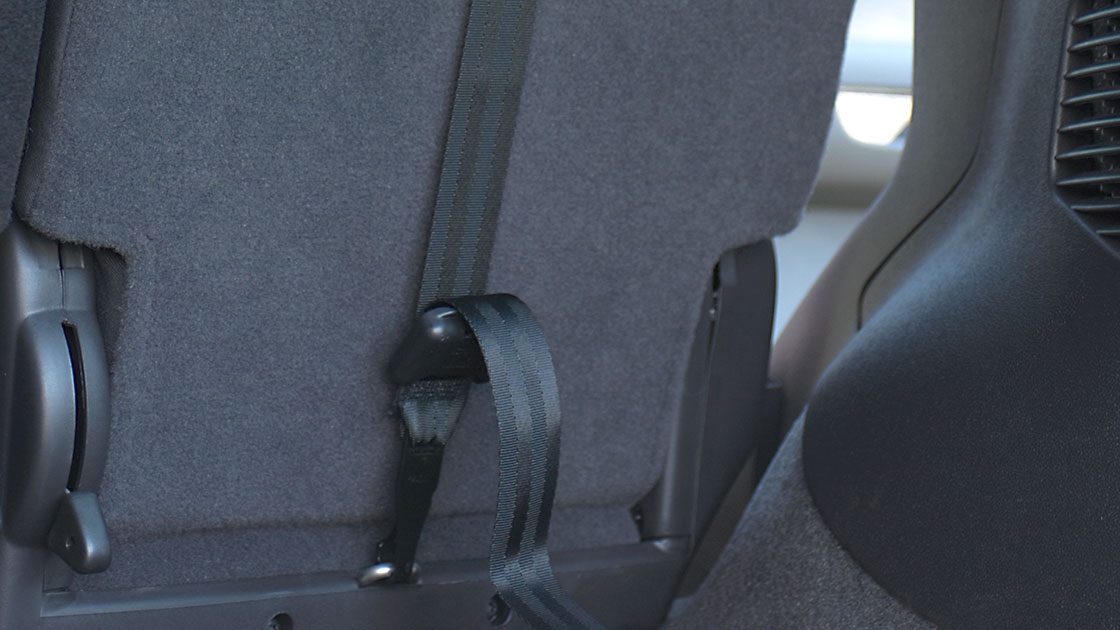Key child restraint strap is often overlooked, misunderstood by parents
April 25, 2013

A simple strap meant to prevent a child restraint from tipping forward in a crash is ignored by lots of parents. It is called a top tether, and a new IIHS study found that it gets used slightly more than half of the time. When parents neglect to attach the tether, it is most often because they don't know it exists. Tethers are part of a child restraint attachment system called Lower Anchors and Tethers for Children, or LATCH. The system is designed to make it easier to correctly install a child restraint. All forward-facing child restraints made since 1999 have a built-in top tether that needs to be attached to an anchor on a vehicle's rear shelf, seat back, floor, cargo area or ceiling. The tether is typically located just behind the upper back of the child restraint.
Parents are more familiar with and likely to use the lower straps and vehicle anchors that make up the other half of LATCH. All child restraints manufactured since 2002 are equipped with attachment straps and fasteners that connect to a pair of anchors situated in the vehicle seat where the bottom cushion and seat back meet.
Child restraints can be installed using the lower LATCH anchors or vehicle safety belts. Top tethers are designed to be used with all forward-facing child restraints, whether they are secured by safety belts or with the lower anchors. Some manufacturers also recommend using a tether with a few rear-facing child restraints.
"Top tethers help prevent head and neck injuries for children in forward-facing restraints, but many parents don't realize they are supposed to use them," says Anne McCartt, IIHS senior vice president for research. "This is a persistent problem. The child passenger safety community could help with a focused effort to educate consumers about top tethers and why they are important."
| Top reasons for not using tether | Percent |
|---|---|
| Didn't know it was there | 22% |
| Didn't know how to use it | 15% |
| In a hurry/not enough time | 13% |
| Unsure where to attach it | 10% |
| Not important or needed | 9% |
| Didn't know they had anchor | 8% |
In the new survey, certified child passenger safety technicians observed the top tether in use 56 percent of the time, more often than seen in previous studies. A 2010 IIHS observational survey of 1,500 forward-facing restraints found tethers in use 43 percent of the time. A 2011 national study by Safe Kids Worldwide of car seat check-up events reported that only 28 percent of the 15,521 forward-facing restraints were tethered.
In the IIHS survey, researchers collected data at roughly 50 suburban sites near Fredericksburg, Va.; Philadelphia; Seattle; and Washington, D.C. Shopping centers, recreation facilities, child-care centers, car-seat checkpoints and health-care facilities were among the locations. Researchers analyzed data for 479 vehicles driven by a parent or caregiver. All of the vehicles had tether anchors and at least one forward-facing child restraint.
Safety was the most important factor in driver decisions to use tethers. Among those in the tether group, 42 percent said they used tethers because the straps make installations safer or more secure, 35 percent said they reduce forward movement of the top of the seat and 27 percent said tethers provide a tighter installation.
Using a tether, however, didn't mean that drivers knew what to call it. Nearly a fifth of drivers who used the tether and had installed the child restraint hadn't heard the term "top tether." More than half of nonusers hadn't heard of the term.
The most common reason drivers cited for not using the tether was that they didn't know their child seat had one. Nearly a quarter of drivers surveyed said this was the case. Fifteen percent didn't know how to use the tether, and 10 percent were unsure where to attach it. Thirteen percent said they were in a hurry or didn't have enough time.
Using the LATCH lower anchors increased the likelihood that drivers would use the top tether, too. Child restraints installed with lower anchors were more than twice as likely to be tethered as child restraints secured with safety belts.
"Many parents haven't gotten the message that the top tether should be used with all forward-facing child restraints, whether they are installed with lower anchors or safety belts," McCartt says.
More than half of child restraints were installed using lower anchors, while 35 percent were secured with safety belts. Seven percent were attached with both belts and LATCH.
When tethers were used, 31 percent were installed the wrong way. The most common kinds of misuse involved loose straps, incorrect routing and twisted straps. These findings are in line with a 2012 LATCH study by IIHS and the University of Michigan Transportation Research Institute. Parents used top tethers 48 percent of the time with forward-facing restraints. When tethers were used, 54 percent of the installations were incorrect.
About a quarter of drivers in the tether group reported trouble using them, mostly because the anchor was difficult to access or the strap was hard to adjust. Nearly a third of drivers who didn't use tethers considered them hard to use. About a third of these drivers didn't know where to attach the tether.
For help, parents should consult the owner's manual for the child restraint as well as the vehicle manual to see how to route and attach the tether, McCartt advises. Nearly half of drivers who used tethers had read the child seat manual. Child safety checkpoints are a good source for hands-on assistance (go to safekids.org to find an event).